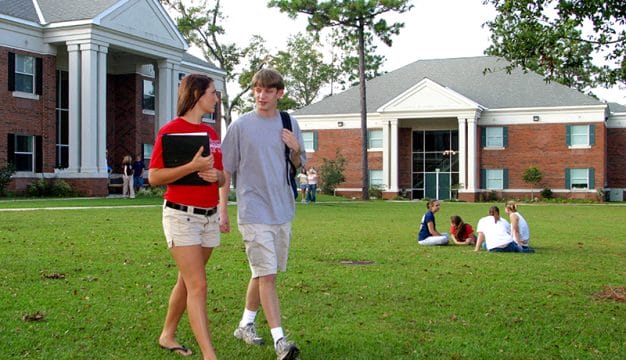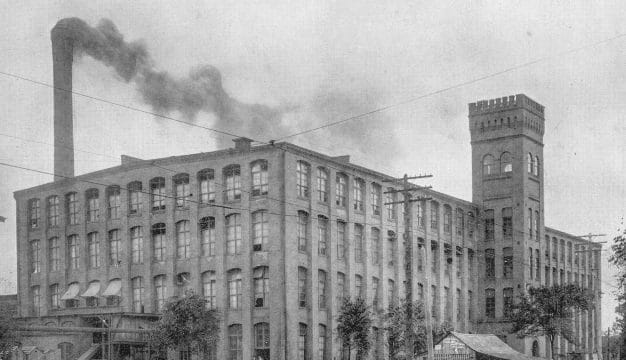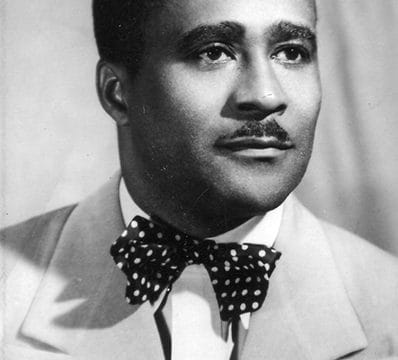Auburn University at Montgomery
 Ida Belle Young Library
Auburn University at Montgomery (AUM) is a branch of Auburn University located on a 500-acre campus in eastern Montgomery, Montgomery County. First opened in 1969 with a total enrollment of almost 600 students, the campus now boasts more than 5,000 undergraduate, graduate, and professional students. AUM’s five colleges—Business, Education, Liberal Arts, Nursing, and Sciences—offer more than 30 programs with more than 130 degree options. AUM awards more than 900 bachelor’s, master’s, and graduate certificates annually. Currently, women make up approximately 63 percent of the student body, and 34 percent of undergraduate students are minorities. AUM’s student to faculty ratio is 16 to 1. Because many students work full time and are already involved in professions, AUM offers flexible class schedules and many evening classes on its main campus as well as at Montgomery’s Maxwell Air Force Base for military officers and civilian graduate students as well as a large number of online classes.
Ida Belle Young Library
Auburn University at Montgomery (AUM) is a branch of Auburn University located on a 500-acre campus in eastern Montgomery, Montgomery County. First opened in 1969 with a total enrollment of almost 600 students, the campus now boasts more than 5,000 undergraduate, graduate, and professional students. AUM’s five colleges—Business, Education, Liberal Arts, Nursing, and Sciences—offer more than 30 programs with more than 130 degree options. AUM awards more than 900 bachelor’s, master’s, and graduate certificates annually. Currently, women make up approximately 63 percent of the student body, and 34 percent of undergraduate students are minorities. AUM’s student to faculty ratio is 16 to 1. Because many students work full time and are already involved in professions, AUM offers flexible class schedules and many evening classes on its main campus as well as at Montgomery’s Maxwell Air Force Base for military officers and civilian graduate students as well as a large number of online classes.
In 1966, Charles Brightwell, president of the Montgomery Area Chamber of Commerce, began examining ways to expand higher education in Montgomery. The chamber quickly focused its attention on an education facility on Bell Street then operated by the University of Alabama. Finding the University of Alabama reluctant to expand operations in Montgomery, in 1967 the committee contacted officials at Auburn University, and the school’s board of trustees agreed to work out a purchase agreement for the Bell Street facility and develop a campus in Montgomery if the state legislature would approve funding.
The Montgomery Chamber of Commerce, Mayor Earl James, Montgomery County Board of Revenue member William F. Joseph Jr., and Auburn President Harry M. Philpott led the initiative to gain legislative approval for the Montgomery campus. Three objectives drove the project forward: building a competitive undergraduate program, providing opportunities for adult education, and developing graduate programs in business, government, public administration, and education. Philpott and the others hoped that the Montgomery extension would follow the model provided by more than 250 similar university branch campuses across the country.
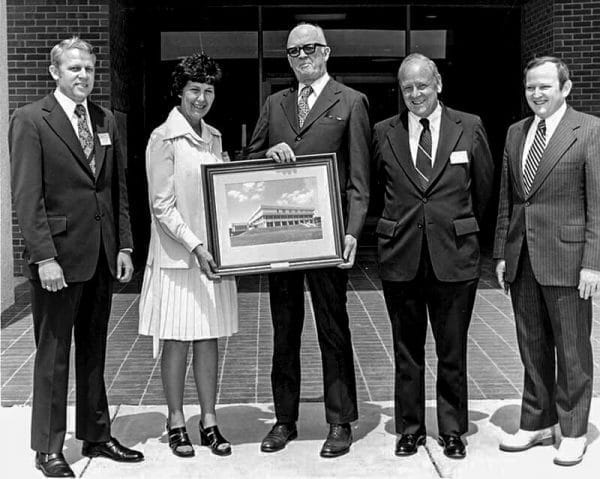 Opening of AUM
State Senator Otis J. “Joe” Goodwyn, chair of the Finance and Taxation Committee, championed the effort in the Alabama State Legislature. In 1967, he introduced Act No. 403, which became known as the Montgomery College Bill, getting it passed in five days. One of the first buildings at AUM would be named Goodwyn Hall in his honor, and the athletic teams carried the name “Senators” for more than 30 years. On September 8, 1967, Gov. Lurleen B. Wallace signed Act No. 403 authorizing $5 million in bonds to fund the new university. Philpott then moved forward with a plan to acquire 500 acres of land, backed by nearly $1 million raised by the city, the County Board of Revenue, local businesses, and citizens. Out of nearly 20 bids received, the choice came down to two sites—a tract located off the Atlanta Highway in east Montgomery and property in south Montgomery. In the end, the east Montgomery site was chosen because soil conditions were better for construction and because it was close to Interstate 85. In March 1968, H. Hanly Funderburk was appointed AU’s Vice President for Montgomery Affairs. Prior to this appointment, Funderburk had been a professor and assistant dean of the Graduate School at Auburn University. In 1978, Funderburk would become AUM’s first chancellor and would later serve a divisive term as president of Auburn University.
Opening of AUM
State Senator Otis J. “Joe” Goodwyn, chair of the Finance and Taxation Committee, championed the effort in the Alabama State Legislature. In 1967, he introduced Act No. 403, which became known as the Montgomery College Bill, getting it passed in five days. One of the first buildings at AUM would be named Goodwyn Hall in his honor, and the athletic teams carried the name “Senators” for more than 30 years. On September 8, 1967, Gov. Lurleen B. Wallace signed Act No. 403 authorizing $5 million in bonds to fund the new university. Philpott then moved forward with a plan to acquire 500 acres of land, backed by nearly $1 million raised by the city, the County Board of Revenue, local businesses, and citizens. Out of nearly 20 bids received, the choice came down to two sites—a tract located off the Atlanta Highway in east Montgomery and property in south Montgomery. In the end, the east Montgomery site was chosen because soil conditions were better for construction and because it was close to Interstate 85. In March 1968, H. Hanly Funderburk was appointed AU’s Vice President for Montgomery Affairs. Prior to this appointment, Funderburk had been a professor and assistant dean of the Graduate School at Auburn University. In 1978, Funderburk would become AUM’s first chancellor and would later serve a divisive term as president of Auburn University.
Not everyone was eager for the new campus to become a reality. The Alabama State Teachers Association (ASTA) filed a class-action suit against the effort, arguing that it was a move to keep white students from attending the all-black Alabama State College (now Alabama State University). The suit was denied by the district court on July 26, 1968, with the court ruling that creating a new institution of higher education in Montgomery was in line with abolishing any racially segregated dual-school system. The U.S. Supreme Court upheld the decision by refusing to hear ASTA’s 1969 appeal. ASTA continued to pursue legal avenues by filing a March 1, 1969, suit to block Act 403 as unconstitutional. Circuit Judge Eugene Carter ruled it constitutional, and the Alabama Supreme Court upheld his decision in April. However, similar issues connecting AUM and other Alabama universities to racial segregation would later surface and be settled through the Supreme Court’s Knight v. State of Alabama. The 1968 court cases cost the state nearly $500,000 and delayed the project for nearly a year.
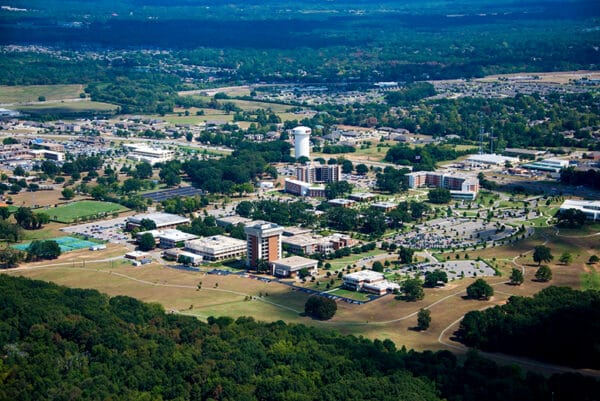 AUM Campus Aerial View
After litigation ended, Auburn University purchased the Bell Street facility for $225,000. Auburn took over the facility following the summer 1968 term. For the 1968-1969 academic year, Auburn operated Bell Street with little change to the faculty or academic programs. During this year, AUM added graduate programs in business and political science that had formerly been administered at Maxwell Air Force Base’s Air University by George Washington University, in Washington, D.C. AUM officially opened on September 16, 1969, with almost 600 registered students. Aside from courses held at Air University and those at a small Selma extension, all AUM courses were conducted in the Bell Street facility, which caused a number of difficulties for faculty, staff, and students, including privacy, noise, and parking concerns.
AUM Campus Aerial View
After litigation ended, Auburn University purchased the Bell Street facility for $225,000. Auburn took over the facility following the summer 1968 term. For the 1968-1969 academic year, Auburn operated Bell Street with little change to the faculty or academic programs. During this year, AUM added graduate programs in business and political science that had formerly been administered at Maxwell Air Force Base’s Air University by George Washington University, in Washington, D.C. AUM officially opened on September 16, 1969, with almost 600 registered students. Aside from courses held at Air University and those at a small Selma extension, all AUM courses were conducted in the Bell Street facility, which caused a number of difficulties for faculty, staff, and students, including privacy, noise, and parking concerns.
Auburn University unveiled a master plan for AUM in October 1969 that included two initial buildings with a combined 134,000 square feet of library, classroom, faculty, and administrative spaces, as well as buildings for athletics, student housing, special programs, and student activities. For the 1970-1971 school year, however, courses continued to be conducted at the Bell Street facility. During the 1971-1972 academic year, the student newspaper, the AUM Aardvark (later The Advocate and then Aumnibus) was established, as was an intramural sports program, a Student Government Association, and a student marketing club. Several prominent state and local figures, including Gov. George Wallace, attended the formal dedication of the new campus in November 1971. For its first full year on the new campus, AUM had 1,543 registered students.
 Harry M. Philpott
From the beginning, Philpott, Funderburk, and other organizers pursued a “one Auburn” concept for the relationship between Auburn University and AUM. Throughout its history, AUM has navigated a complex relationship with Auburn. Early challenges included hostility toward the creation of AUM, competition for resources, salary inequity, and an evolving administrative structure. Recent partnerships and programs including a joint PhD program in Public Administration and AUM Seamless Admissions signaled a return to the “one Auburn” concept.
Harry M. Philpott
From the beginning, Philpott, Funderburk, and other organizers pursued a “one Auburn” concept for the relationship between Auburn University and AUM. Throughout its history, AUM has navigated a complex relationship with Auburn. Early challenges included hostility toward the creation of AUM, competition for resources, salary inequity, and an evolving administrative structure. Recent partnerships and programs including a joint PhD program in Public Administration and AUM Seamless Admissions signaled a return to the “one Auburn” concept.
The Student Center (now the Watson Robbins Taylor Center) was built in 1972 (with an addition in 1979), and the physical education complex was finished in 1976 as a multi-purpose facility with classrooms, athletic courts, recreational areas, and retractable seating for 3,500. Tennis courts and playing fields were added between 1972 and 1976. Student housing for more than 300 students was added in 1979 with the completion of seven designated units. AUM since has added the North Commons housing facility in 2003 and the Warhawk Hall residence facility opened in 2013 to accommodate increased demand for on-campus housing. A state of the art Wellness Center opened in August 2012. Since its establishment, AUM’s rapid physical expansion and partnership with the city of Montgomery have brought millions of dollars to the city, employed thousands of Montgomery and area residents, and helped spur residential and commercial development in eastern Montgomery.
AUM received accreditation as an operationally separate institution in 1973 from the Southern Association of Colleges and Schools (SACS). AUM’s accreditation has been reaffirmed four times, most recently in 2008. Since 1979, the governing structure of AUM has been a chancellor and vice chancellor with oversight from Auburn University’s Board of Trustees. The current chancellor Carl A. Stockton, who began his tenure in 2016.
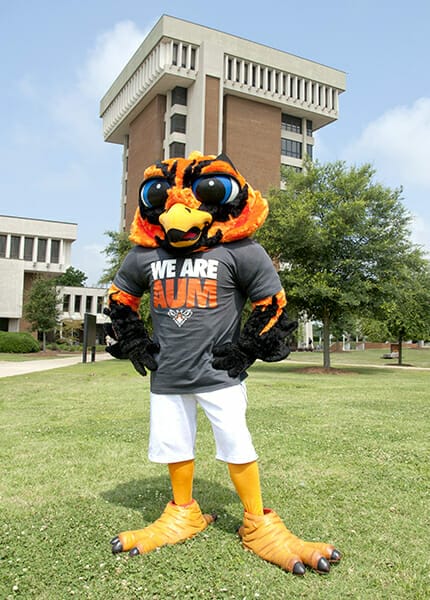 Curtiss the Warhawk
AUM has established strong service programs for the Montgomery area, including the Division of Continuing Education, the Speech and Hearing Clinic, the Center for Business and Economic Development, the Early Childhood Center, Project Read, the Center for Psychological Services, the Center for Government and Public Affairs, and the Montgomery Area Community Health Services Institute.
Curtiss the Warhawk
AUM has established strong service programs for the Montgomery area, including the Division of Continuing Education, the Speech and Hearing Clinic, the Center for Business and Economic Development, the Early Childhood Center, Project Read, the Center for Psychological Services, the Center for Government and Public Affairs, and the Montgomery Area Community Health Services Institute.
AUM joined the National Association of Intercollegiate Athletics (NAIA) in 1975. In 2017, AUM became a provisional member of the larger National Collegiate Athletics Association and gained full membership in 2020. Basketball, baseball, and tennis began NAIA competition as the Senators. Since 1975, AUM athletics has won more than 100 district, conference, and national (NAIA) championships, with the Women’s Tennis program leading the way with 12 national titles including back-to-back titles in 2011 and 2012. AUM’s mascot was changed from Senators to Warhawks in August 2011 to reflect Montgomery’s aviation history by referencing the Curtiss P-40 World War II fighter plane. The schools colors are black and orange.
Further Reading
- Fair, John D. The AUM Story: A Decade of Service to the Montgomery Community. Montgomery, Ala.: Brown Printing Company, 1981.
- ———. The AUM Story: A Second Decade of Service to the Montgomery Community. Montgomery, Ala.: Brown Printing Company, 1989.
